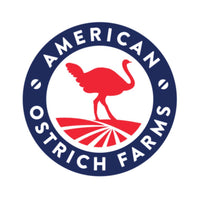
Yet, what if there was another way to support a healthy environment in addition to the tenants of sustainability and purchase responsibility that have come to define the Paleo movement?
Thanks to American Ostrich Farms, there most certainly is.
Located on a 120-acre farm in Boise, Idaho, American Ostrich Farms is dedicated to raising high-quality, sustainable ostrich meat that has the potential to offset the environmental impact that conventional livestock practices exacerbate.
Ostriches? Eco-friendly agriculture? In Idaho? That’s only the beginning.
It took a trip to the southern hemisphere for AOF Founder Alex McCoy to fully understand the impact ostriches could have on the state of meat-eating in America. While working in finance in South Africa, McCoy was introduced to several new cultural practices, including the use of ostrich meat in everyday meals. This seemingly odd custom has a long and storied history in sub-Saharan Africa.
Ostriches were first domesticated in South Africa in the 1850s. In the late 1800s, the industry had exploded, attracting European immigrants to South Africa. They, along with the Boer communities, started raising ostriches in huge quantities in the Little Karoo region of the Western Cape.
The birds were kept mainly for their feathers and their hide – most of which was exported to mainland Europe to keep up with the fashion trends of the time – while the meat was merely an afterthought that the ranchers kept to feed their families. This mindset prevails in present day, as ostrich meat is so commonplace in South Africa that it’s eaten as frequently as chicken.
But the comparison to traditional poultry stops there. Ostriches produce red meat that is 97 percent fat free and has a higher iron content than beef.
This is an important confluence of interests – ostriches offer a source red meat and a lower fat protein source, and the combination of the two ends of the spectrum has the possibility to meet the needs of nearly every community of carnivore.
“We’re creating a third way for people to enjoy red meat and feel good about their environmental impact,” McCoy said. “Our farm offers an alternative to a chicken-based future.”
So what does an ostrich farm look like? McCoy describes his property as a flat, scrubby plain, divided into pastures and pens for various stages of ostrich growth and development. The ostriches at American Ostrich Farms are allowed to mate naturally, and their courtship dance has plenty of room to spread out across the property in all its strange beauty and elegance.
The birds are very social animals, McCoy explained, and they love to be in groups with their same-species companions as well as their human keepers. Great Pyrenees dogs guard the flock from local predators like coyotes and mountain lions, making for a calm, confident and, therefore, healthier flock overall.
Each hen has the potential to lay approximately 50 eggs that hatch to reveal chicks already about a foot tall. These gangly babies grow up fast, gobbling up a mix of cut alfalfa, high-quality corn and soybean feed, and a vitamin and mineral supplement blend. Thanks to their naturally strong immune systems, American Ostrich Farms never uses antibiotics or hormones on their ostriches.
Ostriches require only a quarter of the water that cattle drink, and around half of the land needed to graze a beef herd. Their feed-to-meat ratio is incredibly efficient, as ostriches can turn three to four pounds of feed into a pound of live weight, while the average steer requires 8-12 pounds of feed per pound.
And as an added bonus, ostrich meat has the flavor and texture of a high-quality filet mignon.
The ultimate goal of American Ostrich Farms is to create a viable red meat alternative for all Americans. McCoy wants to put ostrich on grocery store shelves and make ostrich meat a household staple, in much the same way that chicken breast or ground beef is a mainstay in kitchens across the country. An expanded ostrich operation has the potential to revamp the conventional animal husbandry business, taking what can be an environmentally costly operation and turning it into something efficient, sustainable, and green.
This article was original published by Paleo Magazine.
https://paleomagazine.com/the-third-way-ostrich-meat-and-the-future-of-sustainable-agriculture/






